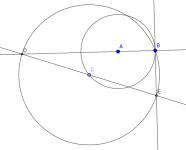beero1000
Veteran Member
Nice geometry puzzle game, I'm through the first few levels so far. Try to get the most efficient constructions...
http://www.euclidea.xyz/
http://www.euclidea.xyz/
Since I'm already stuck trying to get the 7E star on 1.7, I'm going to look at this game as an opportunity to improve my geometry knowledge.
Hell, I can't even get past the Equilateral Triangle.

So I've managed to get all of the stars for the first 6 levels. Some of them took me a while though, I'd be off by 1 or 2 steps for a while and have no idea how to simplify the construction.
Do you think they brute forced it? Crowd sourced? Algebraically solved? Automated theorem provers?
They have another game called Pythagorea that's pretty fun too, if you're interested.
I've given up on getting the L and E stars for every level before I progress--I'm going to revisit them later once I figure out how to solve the puzzles in a systematic way rather than relying so heavily on guesswork.
It is some consolation that you have not all-starred al 13 sets.
Do you think they brute forced it? Crowd sourced? Algebraically solved? Automated theorem provers?
Yes.
They have another game called Pythagorea that's pretty fun too, if you're interested.
Maybe after Euclidea has finished destroying my life.
I'm not solving everything... i cant even understand how some of the solution works after I!ve seen them... possible spoiler:
how does these 90 degree angles constructed by three circles and a line work? (2.8)
They are like magic to me...

bah... did the rhombus in 1E less than it wanted and it wouldn't give credit. It was fun for a few minutes, though.
bah... did the rhombus in 1E less than it wanted and it wouldn't give credit. It was fun for a few minutes, though.
Mind sharing that construction?
Mind sharing that construction?
Can't share a pic, but it was constructed with two circles only... center on one corner, radius to the other corner on the short end, then the other circle is mirror image of that circle. The intersection of the circles with the rectangle are the corners of the rhombus. It is 4L 4E, including the lines.
bah... did the rhombus in 1E less than it wanted and it wouldn't give credit. It was fun for a few minutes, though.
bah... did the rhombus in 1E less than it wanted and it wouldn't give credit. It was fun for a few minutes, though.
I tried several things but couldn't get it to accept anything. Not sure if I didn't quite have it, or if something else was causing it not to give me credit.
bah... did the rhombus in 1E less than it wanted and it wouldn't give credit. It was fun for a few minutes, though.
I tried several things but couldn't get it to accept anything. Not sure if I didn't quite have it, or if something else was causing it not to give me credit.
